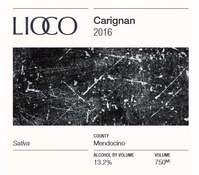 This Carignan comes from low-yield, old-vine grapes grown in a remote, dry-farmed, south-facing vineyard 2400 feet high on Pine Mountain. The vineyard straddles the Sonoma County-Mendocino County border, and qualifies for the Pine Mountain-Cloverdale Peak AVA, but it has historically been classified as Mendocino County, and the wine carries the Mendocino designation. The vineyard is owned by reclusive octogenarian Jim McCutchen, who planted the vines himself about 70 years ago, and continues to tend the untrellised, head-pruned vines.
This Carignan comes from low-yield, old-vine grapes grown in a remote, dry-farmed, south-facing vineyard 2400 feet high on Pine Mountain. The vineyard straddles the Sonoma County-Mendocino County border, and qualifies for the Pine Mountain-Cloverdale Peak AVA, but it has historically been classified as Mendocino County, and the wine carries the Mendocino designation. The vineyard is owned by reclusive octogenarian Jim McCutchen, who planted the vines himself about 70 years ago, and continues to tend the untrellised, head-pruned vines.
(I asked Lioco owner Matt Licklider why this wine carries the name, Sativa. “All of our appellation level wines are named after a feature in nature that most influences the region,” he responded. “Our Chardonnay from the Russian River Valley is known as Estero, the Spanish word for estuary. Our Pinot Noir from the Sonoma Coast is called Laguna, for lagoon. Sativa refers to a strain of cannabis, which by every account is the driving force of Mendocino County.”)
The vinification regime that Lioco winemaker John Raytek uses for these grapes is a simple, old-fashioned one that might have been used in the era when the vines were planted. After careful selection of the best bunches of grapes, he ferments the whole-clusters for 18 days with a “submerged cap” to keep the fermenting wine in constant contact with the skins and stems. The wine then ages in neutral oak for nine months. These techniques have the effect of bringing brightness and freshness to the wine while also integrating the grape tannins with the fruit.
The 2016 Lioco Carignan is a dry, medium-bodied red wine with moderate tannin and an energetic, lively personality. Its bright aromas and flavors suggest red fruits such as cranberry, raspberry, and plum; black fruits such as black cherry and blackberry; and spicy pepper. Along with the fruit and spice notes, you might find an edge of tartness to the flavor, a slightly wild, “green” character, and a suggestion of damp earth. These are characteristics that set this wine apart from wines made from mainstream grape varieties, such as Pinot Noir. While this wine is structurally somewhat similar to some cool-climate Pinot Noirs — high acidity, moderate weight, medium tannins — the untamed, edgy flavors present a whole different face from Pinot Noir’s fruity seduction.
This wine is refreshing, juicy, mouthwatering, complex in flavor and, by its very existence, provocative. Completely enjoyable now, it has the structure to develop for several years. Personally, I will drink it sooner rather than later because I treasure the wine’s raw energy, which aging might tame.
90 Points
